 American Journal of Plant Sciences, 2013, 4, 2227-2239 Published Online November 2013 (http://www.scirp.org/journal/ajps) http://dx.doi.org/10.4236/ajps.2013.411276 Open Access AJPS 2227 Seed Vigor Variation of Agave durangensis Gentry (Agavaceae) Gerardo Barriada-Bernal1, Norma Almaraz-Abarca1*, Tzahyri Gallardo-Velázquez2, Isabel Torres-Morán3, Yolanda Herrera-Arrieta1, Socorro González-Elizondo1, Eli Amanda Delgado-Alvarado1 1Interdisciplinary Research Center for the Integral Regional Development, Durango, National Polytechnical Institute (CIIDIR IPN Durango), Durango, México; 2National School of Biological Sciences, National Polytechnical Institute (ENCB IPN), México DF, México; 3University Center of Biological and Agropecuary Sciences, University of Guadalajara (CUCBA), Zapopan, México. Email: *nalmaraz@ipn.mx Received September 27th, 2013; revised October 20th, 2013; accepted October 29th, 2013 Copyright © 2013 Gerardo Barriada-Bernal et al. This is an open access article distributed under the Creative Commons Attribution License, which permits unrestricted use, distribution, and reproduction in any medium, provided the original work is properly cited. ABSTRACT Agave durangensis propagates basically by seeds. This species is economically important because it supports a mescal industry in Durango, Mexico. At present, its exploitation is overall by collecting plants from the wild populations. In order to reduce the negative impact of the collection in the natural populations of A. durangensis and to improve the mescal industry, it is necessary to establish plantations with selected seeds for a high vigor. In this paper, the variation in morphological features, physiological behavior of germination, and biochemical indicators of seed vigor among three natural populations of A. durangensis was assessed. Variation was found in the seed weight (0.68 to 1.15 mg/seed), seed dimensions (3.51 × 5.29 to 4.62 × 5.92 mm), germinability reduction at 15˚C related to 25˚C (4% to 51%), germination rate at 25˚C (44.0 to 48.5 seeds/day) and at 15˚C (5.17 to 6.77 seeds/day), development reduction at 15˚C related to 25˚C (86.66% to 91.99%), levels of seed accumulated phenols (71 to 85 µg/seed), antioxidant potential (42% to 50% reduction of DPPH*), seed alcohol dehydrogenase activity (ADH) (180 to 1100 µmol NAD+/mg protein/min), highest ADH activity after imbibitions at 25˚C (310.24 to 520.2 µmol NAD+/mg protein/min), and highest ADH activity after imbibitions at 15˚C (170.74 to 440.71 µmol NAD+/mg protein/min). The variation in the seed vigor was revealed by a principal component analysis (PCA) based on all the parameters evaluated. PCA clearly discriminated among the three populations. Keywords: Agave Durangensis; Seed Vigor; Germinability; Natural Variation 1. Introduction Agave durangensis Gentry is the base of a mescal indus- try in Durango, Mexico. At present, its exploitation is carried out by collecting plants from the wild populations [1], which is causing the reduction and fragmentation of its natural distribution [2]. Agave durangensis propagates basically by seeds, and under natural conditions it is in- frequent to observe offshoots; this favors high levels of genetic variability [2], which may represent a source of worthy alleles to select for the establishment of commer- cial plantations. Thus, it is relevant to carry out studies to assess the variability in the seed vigor among its natural populations. Natural variability in the seed vigor has been found among varieties of cultivated species [3] as well as among the natural populations of wild species [4]. The definition of seed vigor given by the Association of Official Seed Analyst’s Vigor Committee in 1979 was mentioned by McDonald [5] as those seed properties determine the potential for rapid, uniform emergence and development of normal seedlings under a wide range of field conditions. Seed vigor has genetic and environ- mental determinants [3]. Most tests to evaluate the vigor of seeds consider the germination behavior [6,7] and the deterioration of that behavior under condition of stress [8]. The correlation between the morphological, physio- logical and biochemical indicators of seed vigor may assist to broad the understanding of how the vigor is *Corresponding author. 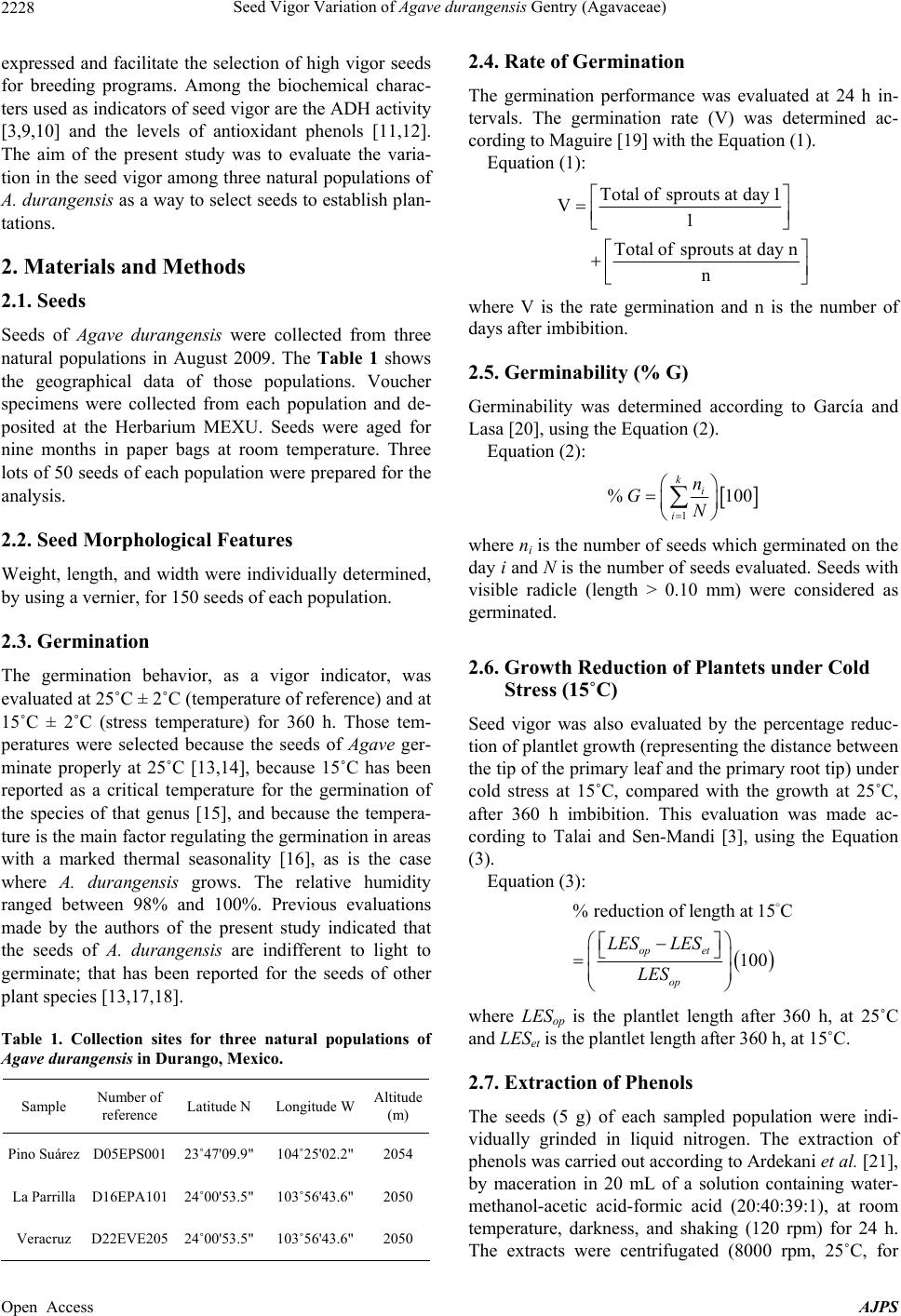 Seed Vigor Variation of Agave durangensis Gentry (Agavaceae) 2228 expressed and facilitate the selection of high vigor seeds for breeding programs. Among the biochemical charac- ters used as indicators of seed vigor are the ADH activity [3,9,10] and the levels of antioxidant phenols [11,12]. The aim of the present study was to evaluate the varia- tion in the seed vigor among three natural populations of A. durangensis as a way to select seeds to establish plan- tations. 2. Materials and Methods 2.1. Seeds Seeds of Agave durangensis were collected from three natural populations in August 2009. The Table 1 shows the geographical data of those populations. Voucher specimens were collected from each population and de- posited at the Herbarium MEXU. Seeds were aged for nine months in paper bags at room temperature. Three lots of 50 seeds of each population were prepared for the analysis. 2.2. Seed Morphological Features Weight, length, and width were individually determined, by using a vernier, for 150 seeds of each population. 2.3. Germination The germination behavior, as a vigor indicator, was evaluated at 25˚C ± 2˚C (temperature of reference) and at 15˚C ± 2˚C (stress temperature) for 360 h. Those tem- peratures were selected because the seeds of Agave ger- minate properly at 25˚C [13,14], because 15˚C has been reported as a critical temperature for the germination of the species of that genus [15], and because the tempera- ture is the main factor regulating the germination in areas with a marked thermal seasonality [16], as is the case where A. durangensis grows. The relative humidity ranged between 98% and 100%. Previous evaluations made by the authors of the present study indicated that the seeds of A. durangensis are indifferent to light to germinate; that has been reported for the seeds of other plant species [13,17,18]. Table 1. Collection sites for three natural populations of Agave durangensis in Durango, Mexico. Sample Number of reference Latitude N Longitude WAltitude (m) Pino Suárez D05EPS001 23˚47'09.9" 104˚25'02.2"2054 La Parrilla D16EPA101 24˚00'53.5" 103˚56'43.6" 2050 Veracruz D22EVE205 24˚00'53.5" 103˚56'43.6"2050 2.4. Rate of Germination The germination performance was evaluated at 24 h in- tervals. The germination rate (V) was determined ac- cording to Maguire [19] with the Equation (1). Equation (1): Totalofsproutsatday 1 V1 Total ofsprouts atday n n where V is the rate germination and n is the number of days after imbibition. 2.5. Germinability (% G) Germinability was determined according to García and Lasa [20], using the Equation (2). Equation (2): 1 %1 k i i n GN 00 where ni is the number of seeds which germinated on the day i and N is the number of seeds evaluated. Seeds with visible radicle (length > 0.10 mm) were considered as germinated. 2.6. Growth Reduction of Plantets under Cold Stress (15˚C) Seed vigor was also evaluated by the percentage reduc- tion of plantlet growth (representing the distance between the tip of the primary leaf and the primary root tip) under cold stress at 15˚C, compared with the growth at 25˚C, after 360 h imbibition. This evaluation was made ac- cording to Talai and Sen-Mandi [3], using the Equation (3). Equation (3): % reduction of lengCth at 15 100 op et op LES LES LES where LESop is the plantlet length after 360 h, at 25˚C and LESet is the plantlet length after 360 h, at 15˚C. 2.7. Extraction of Phenols The seeds (5 g) of each sampled population were indi- vidually grinded in liquid nitrogen. The extraction of phenols was carried out according to Ardekani et al. [21], by maceration in 20 mL of a solution containing water- methanol-acetic acid-formic acid (20:40:39:1), at room temperature, darkness, and shaking (120 rpm) for 24 h. The extracts were centrifugated (8000 rpm, 25˚C, for Open Access AJPS 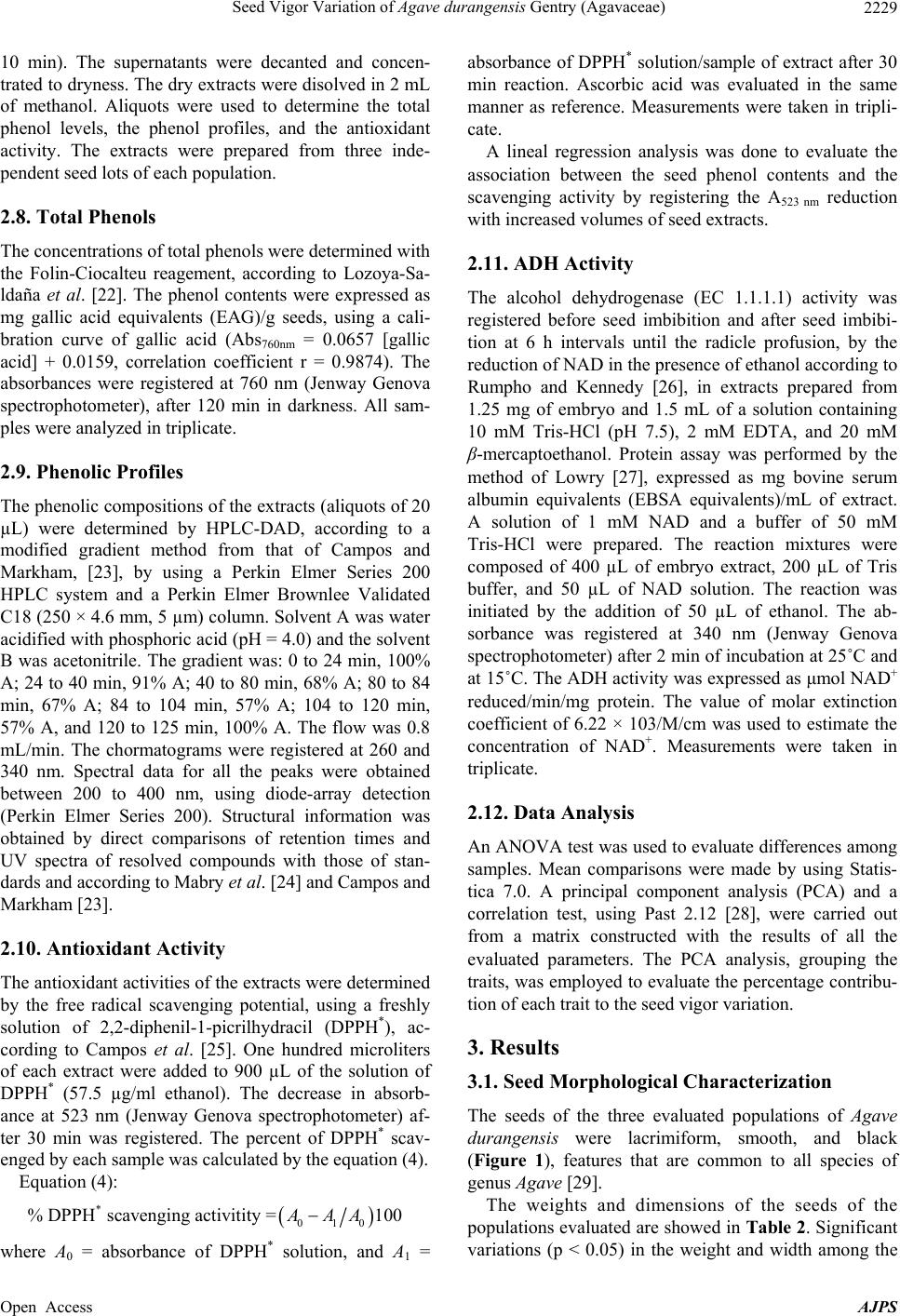 Seed Vigor Variation of Agave durangensis Gentry (Agavaceae) 2229 10 min). The supernatants were decanted and concen- trated to dryness. The dry extracts were disolved in 2 mL of methanol. Aliquots were used to determine the total phenol levels, the phenol profiles, and the antioxidant activity. The extracts were prepared from three inde- pendent seed lots of each population. 2.8. Total Phenols The concentrations of total phenols were determined with the Folin-Ciocalteu reagement, according to Lozoya-Sa- ldaña et al. [22]. The phenol contents were expressed as mg gallic acid equivalents (EAG)/g seeds, using a cali- bration curve of gallic acid (Abs760nm = 0.0657 [gallic acid] + 0.0159, correlation coefficient r = 0.9874). The absorbances were registered at 760 nm (Jenway Genova spectrophotometer), after 120 min in darkness. All sam- ples were analyzed in triplicate. 2.9. Phenolic Profiles The phenolic compositions of the extracts (aliquots of 20 µL) were determined by HPLC-DAD, according to a modified gradient method from that of Campos and Markham, [23], by using a Perkin Elmer Series 200 HPLC system and a Perkin Elmer Brownlee Validated C18 (250 × 4.6 mm, 5 µm) column. Solvent A was water acidified with phosphoric acid (pH = 4.0) and the solvent B was acetonitrile. The gradient was: 0 to 24 min, 100% A; 24 to 40 min, 91% A; 40 to 80 min, 68% A; 80 to 84 min, 67% A; 84 to 104 min, 57% A; 104 to 120 min, 57% A, and 120 to 125 min, 100% A. The flow was 0.8 mL/min. The chormatograms were registered at 260 and 340 nm. Spectral data for all the peaks were obtained between 200 to 400 nm, using diode-array detection (Perkin Elmer Series 200). Structural information was obtained by direct comparisons of retention times and UV spectra of resolved compounds with those of stan- dards and according to Mabry et al. [24] and Campos and Markham [23]. 2.10. Antioxidant Activity The antioxidant activities of the extracts were determined by the free radical scavenging potential, using a freshly solution of 2,2-diphenil-1-picrilhydracil (DPPH*), ac- cording to Campos et al. [25]. One hundred microliters of each extract were added to 900 µL of the solution of DPPH* (57.5 µg/ml ethanol). The decrease in absorb- ance at 523 nm (Jenway Genova spectrophotometer) af- ter 30 min was registered. The percent of DPPH* scav- enged by each sample was calculated by the equation (4). Equation (4): * 010 % DPPHscavengingactivitity =100AAA where A0 = absorbance of DPPH* solution, and A1 = absorbance of DPPH* solution/sample of extract after 30 min reaction. Ascorbic acid was evaluated in the same manner as reference. Measurements were taken in tripli- cate. A lineal regression analysis was done to evaluate the association between the seed phenol contents and the scavenging activity by registering the A523 nm reduction with increased volumes of seed extracts. 2.11. ADH Activity The alcohol dehydrogenase (EC 1.1.1.1) activity was registered before seed imbibition and after seed imbibi- tion at 6 h intervals until the radicle profusion, by the reduction of NAD in the presence of ethanol according to Rumpho and Kennedy [26], in extracts prepared from 1.25 mg of embryo and 1.5 mL of a solution containing 10 mM Tris-HCl (pH 7.5), 2 mM EDTA, and 20 mM β-mercaptoethanol. Protein assay was performed by the method of Lowry [27], expressed as mg bovine serum albumin equivalents (EBSA equivalents)/mL of extract. A solution of 1 mM NAD and a buffer of 50 mM Tris-HCl were prepared. The reaction mixtures were composed of 400 µL of embryo extract, 200 µL of Tris buffer, and 50 µL of NAD solution. The reaction was initiated by the addition of 50 µL of ethanol. The ab- sorbance was registered at 340 nm (Jenway Genova spectrophotometer) after 2 min of incubation at 25˚C and at 15˚C. The ADH activity was expressed as μmol NAD+ reduced/min/mg protein. The value of molar extinction coefficient of 6.22 × 103/M/cm was used to estimate the concentration of NAD+. Measurements were taken in triplicate. 2.12. Data Analysis An ANOVA test was used to evaluate differences among samples. Mean comparisons were made by using Statis- tica 7.0. A principal component analysis (PCA) and a correlation test, using Past 2.12 [28], were carried out from a matrix constructed with the results of all the evaluated parameters. The PCA analysis, grouping the traits, was employed to evaluate the percentage contribu- tion of each trait to the seed vigor variation. 3. Results 3.1. Seed Morphological Characterization The seeds of the three evaluated populations of Agave durangensis were lacrimiform, smooth, and black (Figure 1), features that are common to all species of genus Agave [29]. The weights and dimensions of the seeds of the populations evaluated are showed in Tabl e 2. Significant variations (p < 0.05) in the weight and width among the Open Access AJPS 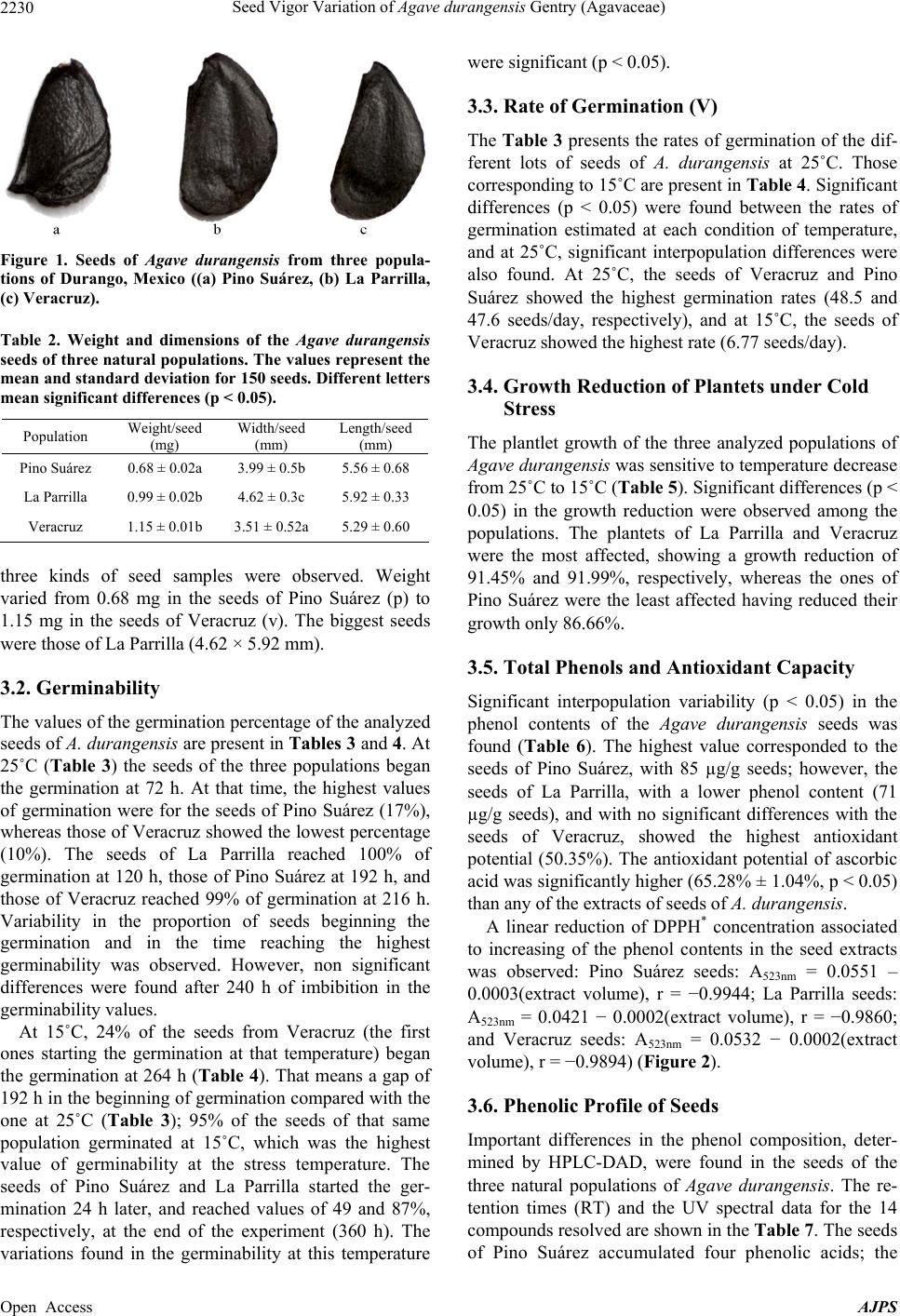 Seed Vigor Variation of Agave durangensis Gentry (Agavaceae) 2230 Figure 1. Seeds of Agave durangensis from three popula- tions of Durango, Mexico ((a) Pino Suárez, (b) La Parrilla, (c) Veracruz). Table 2. Weight and dimensions of the Agave durangensis seeds of three natural populations. The values represent the mean and standard deviation for 150 seeds. Different letters mean significant differences (p < 0.05). Population Weight/seed (mg) Width/seed (mm) Length/seed (mm) Pino Suárez 0.68 ± 0.02a 3.99 ± 0.5b 5.56 ± 0.68 La Parrilla 0.99 ± 0.02b 4.62 ± 0.3c 5.92 ± 0.33 Veracruz 1.15 ± 0.01b 3.51 ± 0.52a 5.29 ± 0.60 three kinds of seed samples were observed. Weight varied from 0.68 mg in the seeds of Pino Suárez (p) to 1.15 mg in the seeds of Veracruz (v). The biggest seeds were those of La Parrilla (4.62 × 5.92 mm). 3.2. Germinability The values of the germination percentage of the analyzed seeds of A. durangensis are present in Tabl es 3 and 4. At 25˚C (Table 3) the seeds of the three populations began the germination at 72 h. At that time, the highest values of germination were for the seeds of Pino Suárez (17%), whereas those of Veracruz showed the lowest percentage (10%). The seeds of La Parrilla reached 100% of germination at 120 h, those of Pino Suárez at 192 h, and those of Veracruz reached 99% of germination at 216 h. Variability in the proportion of seeds beginning the germination and in the time reaching the highest germinability was observed. However, non significant differences were found after 240 h of imbibition in the germinability values. At 15˚C, 24% of the seeds from Veracruz (the first ones starting the germination at that temperature) began the germination at 264 h (Table 4). That means a gap of 192 h in the beginning of germination compared with the one at 25˚C (Table 3); 95% of the seeds of that same population germinated at 15˚C, which was the highest value of germinability at the stress temperature. The seeds of Pino Suárez and La Parrilla started the ger- mination 24 h later, and reached values of 49 and 87%, respectively, at the end of the experiment (360 h). The variations found in the germinability at this temperature were significant (p < 0.05). 3.3. Rate of Germination (V) The Table 3 presents the rates of germination of the dif- ferent lots of seeds of A. durangensis at 25˚C. Those corresponding to 15˚C are present in Tabl e 4 . Significant differences (p < 0.05) were found between the rates of germination estimated at each condition of temperature, and at 25˚C, significant interpopulation differences were also found. At 25˚C, the seeds of Veracruz and Pino Suárez showed the highest germination rates (48.5 and 47.6 seeds/day, respectively), and at 15˚C, the seeds of Veracruz showed the highest rate (6.77 seeds/day). 3.4. Growth Reduction of Plantets under Cold Stress The plantlet growth of the three analyzed populations of Agave durangensis was sensitive to temperature decrease from 25˚C to 15˚C (Table 5). Significant differences (p < 0.05) in the growth reduction were observed among the populations. The plantets of La Parrilla and Veracruz were the most affected, showing a growth reduction of 91.45% and 91.99%, respectively, whereas the ones of Pino Suárez were the least affected having reduced their growth only 86.66%. 3.5. Total Phenols and Antioxidant Capacity Significant interpopulation variability (p < 0.05) in the phenol contents of the Agave durangensis seeds was found (Table 6). The highest value corresponded to the seeds of Pino Suárez, with 85 µg/g seeds; however, the seeds of La Parrilla, with a lower phenol content (71 µg/g seeds), and with no significant differences with the seeds of Veracruz, showed the highest antioxidant potential (50.35%). The antioxidant potential of ascorbic acid was significantly higher (65.28% ± 1.04%, p < 0.05) than any of the extracts of seeds of A. durangensis. A linear reduction of DPPH* concentration associated to increasing of the phenol contents in the seed extracts was observed: Pino Suárez seeds: A523nm = 0.0551 – 0.0003(extract volume), r = −0.9944; La Parrilla seeds: A523nm = 0.0421 − 0.0002(extract volume), r = −0.9860; and Veracruz seeds: A523nm = 0.0532 − 0.0002(extract volume), r = −0.9894) (Figure 2). 3.6. Phenolic Profile of Seeds Important differences in the phenol composition, deter- mined by HPLC-DAD, were found in the seeds of the three natural populations of Agave durangensis. The re- tention times (RT) and the UV spectral data for the 14 compounds resolved are shown in the Table 7 . The seeds of Pino Suárez accumulated four phenolic acids; the Open Access AJPS 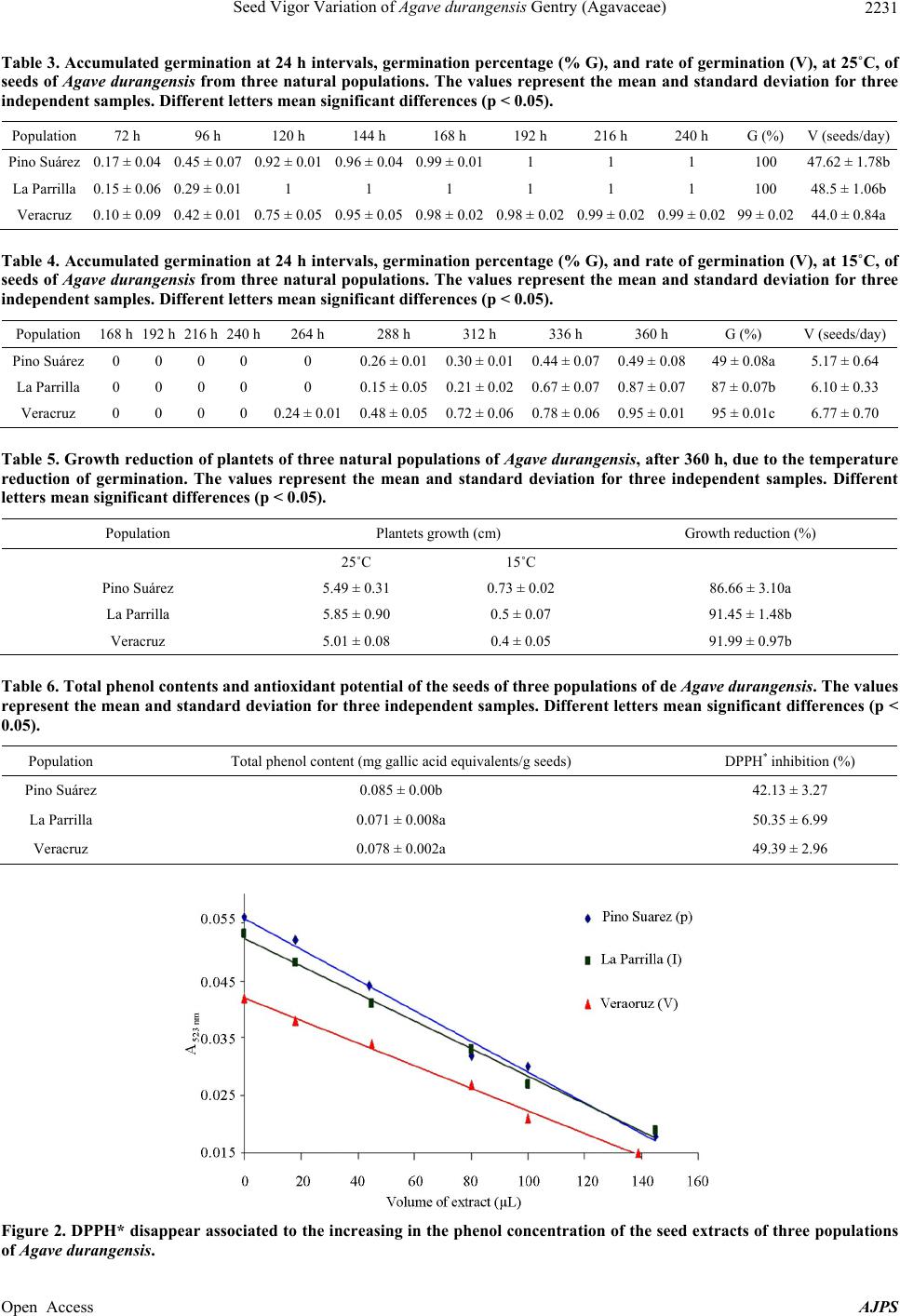 Seed Vigor Variation of Agave durangensis Gentry (Agavaceae) Open Access AJPS 2231 Table 3. Accumulated germination at 24 h intervals, germination percentage (% G), and rate of germination (V), at 25˚C, of seeds of Agave durangensis from three natural populations. The values represent the mean and standard deviation for three independent samples. Different letters mean significant differences (p < 0.05). Population 72 h 96 h 120 h 144 h 168 h 192 h 216 h 240 h G (%) V (seeds/day) Pino Suárez 0.17 ± 0.04 0.45 ± 0.07 0.92 ± 0.01 0.96 ± 0.040.99 ± 0.011 1 1 100 47.62 ± 1.78b La Parrilla 0.15 ± 0.06 0.29 ± 0.01 1 1 1 1 1 1 100 48.5 ± 1.06b Veracruz 0.10 ± 0.09 0.42 ± 0.01 0.75 ± 0.05 0.95 ± 0.050.98 ± 0.020.98 ± 0.020.99 ± 0.020.99 ± 0.02 99 ± 0.02 44.0 ± 0.84a Table 4. Accumulated germination at 24 h intervals, germination percentage (% G), and rate of germination (V), at 15˚C, of seeds of Agave durangensis from three natural populations. The values represent the mean and standard deviation for three independent samples. Different letters mean significant differences (p < 0.05). Population 168 h 192 h 216 h 240 h 264 h 288 h 312 h 336 h 360 h G (%) V (seeds/day) Pino Suárez 0 0 0 0 0 0.26 ± 0.010.30 ± 0.010.44 ± 0.070.49 ± 0.08 49 ± 0.08a 5.17 ± 0.64 La Parrilla 0 0 0 0 0 0.15 ± 0.050.21 ± 0.020.67 ± 0.070.87 ± 0.07 87 ± 0.07b 6.10 ± 0.33 Veracruz 0 0 0 0 0.24 ± 0.01 0.48 ± 0.050.72 ± 0.060.78 ± 0.060.95 ± 0.01 95 ± 0.01c 6.77 ± 0.70 Table 5. Growth reduction of plantets of three natural populations of Agave durangensis, after 360 h, due to the temperature reduction of germination. The values represent the mean and standard deviation for three independent samples. Different letters mean significant differences (p < 0.05). Population Plantets growth (cm) Growth reduction (%) 25˚C 15˚C Pino Suárez 5.49 ± 0.31 0.73 ± 0.02 86.66 ± 3.10a La Parrilla 5.85 ± 0.90 0.5 ± 0.07 91.45 ± 1.48b Veracruz 5.01 ± 0.08 0.4 ± 0.05 91.99 ± 0.97b Table 6. Total phenol contents and antioxidant potential of the seeds of three populations of de Agave durangensis. The values represent the mean and standard deviation for three independent samples. Different letters mean significant differences (p < 0.05). Population Total phenol content (mg gallic acid equivalents/g seeds) DPPH* inhibition (%) Pino Suárez 0.085 ± 0.00b 42.13 ± 3.27 La Parrilla 0.071 ± 0.008a 50.35 ± 6.99 Veracruz 0.078 ± 0.002a 49.39 ± 2.96 Figure 2. DPPH* disappear associated to the increasing in the phenol concentration of the seed extracts of three populations of Agave durangensis.  Seed Vigor Variation of Agave durangensis Gentry (Agavaceae) 2232 Table 7. Retention time and spectral data of the phenolic compounds found in the seeds of three populations of Agave du- rangensis. Location Number of Compound Type of phenolic compound λmax (nm) RT (min) Pino Suárez 1 O-coumaric acid derivative 240 sh, 272, 302 sh 70.462 2 Phenolic acid 272 78.236 3 Phenolic acid 247 96.393 4 Phrnolic acid 282 sh, 295 116.956 La Parrilla 5 Phenolic acid 235 sh, 290, 320 sh 64.346 6 Dihydroflavonoid 280, 310 sh 68.556 7 Flavonol, possible herbacetin derivative 273, 296 sh, 317 sh 70.58 8 Phrnolic acid 230 sh, 277, 315 74.129 9 Phenolic acid 240, 305 sh 322 77.4 10 Flavone, possible scutellarein derivative 272, 330 83.926 11 Flavone, possible scutellarein derivative 272, 330 95.66 12 Flavone, possible scutellarein derivative 274, 330 97.405 Veracruz 13 Phenolic acid 290, 320 50.824 14 Dihydroflavonoid 290, 320 sh 61.432 7 Flavonol, possible herbacetin derivative 273, 296 sh, 317 sh 70.389 3 Phenolic acid 247 96.276 seeds of La Parrilla, three phenolic acids, one dihy- droflavonoid, one flavonol, and three flavones; and the seeds of Veracruz, two phenolic acids, one dihydrofla- vonoid, and one flavonol. The compound 3, a phenolic acid, was common to the seeds of Pino Suárez and those of Veracruz, and the compound 7, one flavonol, possible derivated of the flavonol herbacetin, was common to the seeds of La Parrilla and to those of Veracruz. The re- spective chromatograms are displayed in Figure 3. 3.7. ADH Activity Significant variability (p < 0.05) in the ADH activity of the seeds, before inbibition, among the three natural populations of Agave durangensis was found (Figure 4), being the highest for the seeds of Pino Suárez (1100 μmol NAD+/mg protein/min), and the lowest for the seeds of La Parrilla (180 μmol NAD+/mg protein/min). At 25˚C and in imbibitions conditions, after a con- tinuous diminish for 6 h, the ADH activities of the seeds of Veracruz and Pino Suárez, increased to reach a high level (520.2 and 400.9 μmol NAD+/mg protein/min, re- spectively) at 12 h after imbibition. The seeds of La Parrilla reached latter (18 h after imbibition) their highest level of ADH activity (310.24 μmol NAD+/mg pro- tein/min) (Figure 4). The highest level after imbibitions of the ADH activity at 15˚C was observed in the seeds of Veracruz (440.71 μmol NAD+/mg protein/min). Lower activities were es- timated for the seeds of Pino Suárez and La Parrilla (170.74 and 185.62 μmol NAD+/mg protein/min, respec- tively). The seeds of Veracruz reached the highest ADH activity sooner (at the 12th day after imbibition) than the seeds of La Parrilla and Pino Suárez (both at the 24th day after imbibition) (Figure 5). The time taken for the diminution of the ADH activity by the three populations at this temperature was longer than at 25˚C (Figures 4 and 5), and this gap matched with the delay in the ger- mination at 15˚C (Table 4). 3.8. PCA and Correlation Analysis The results of a PCA, based on the genetic variability revealed by the different indicators of seed vigor, are showed in the Figure 6. The clear discrimination between the three natural populations of Agave duran- gensis can be observed. Six principal components accounted for practically 100% of total variance, being the PC1 the mean one, taking 78.9%; this same component had the highest relative discriminating power (eigen value 190774) and the PC6 had the lowest relative discriminating power (eigen value 4.299) (data not shown). The PC1 was mostly correlated with the germinability at 15˚C, rate germination at 15˚C, weight, and growth reduction; PC2 with the ADH activity at both temperatures; PC3 with the germinability at 25˚C; PC4 with the growth reduction; PC5 with the DPPH scavenging; and PC6 with the ADH activity at 25˚C. The correlation coefficients for the pairs of the seed Open Access AJPS 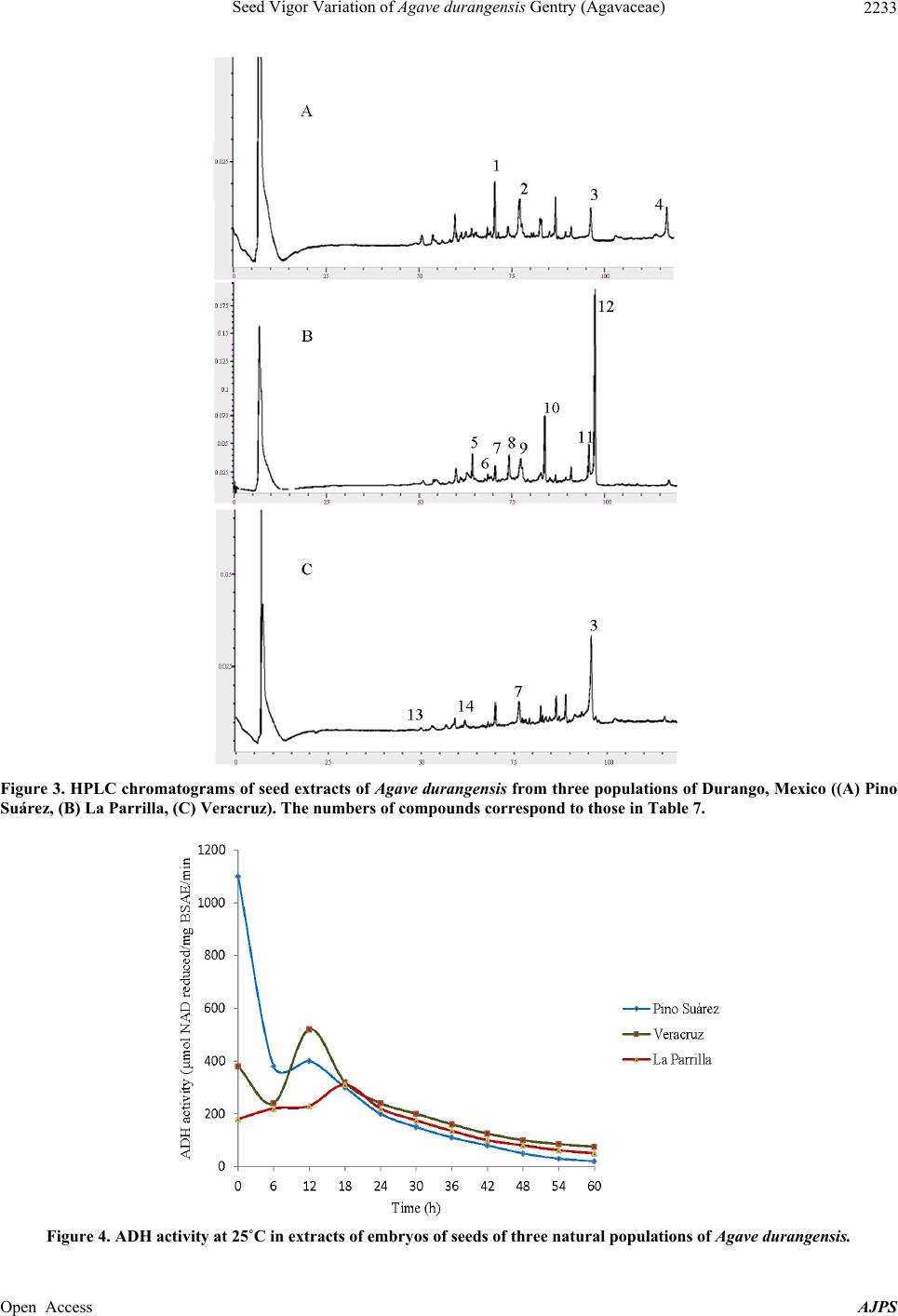 Seed Vigor Variation of Agave durangensis Gentry (Agavaceae) 2233 Figure 3. HPLC chromatograms of seed extracts of Agave durangensis from three populations of Durango, Mexico ((A) Pino Suárez, (B) La Parrilla, (C) Veracruz). The numbers of compounds correspond to those in Table 7. Figure 4. ADH activity at 25˚C in extracts of embryos of seeds of three natur al populations of Agave durangensis. Open Access AJPS 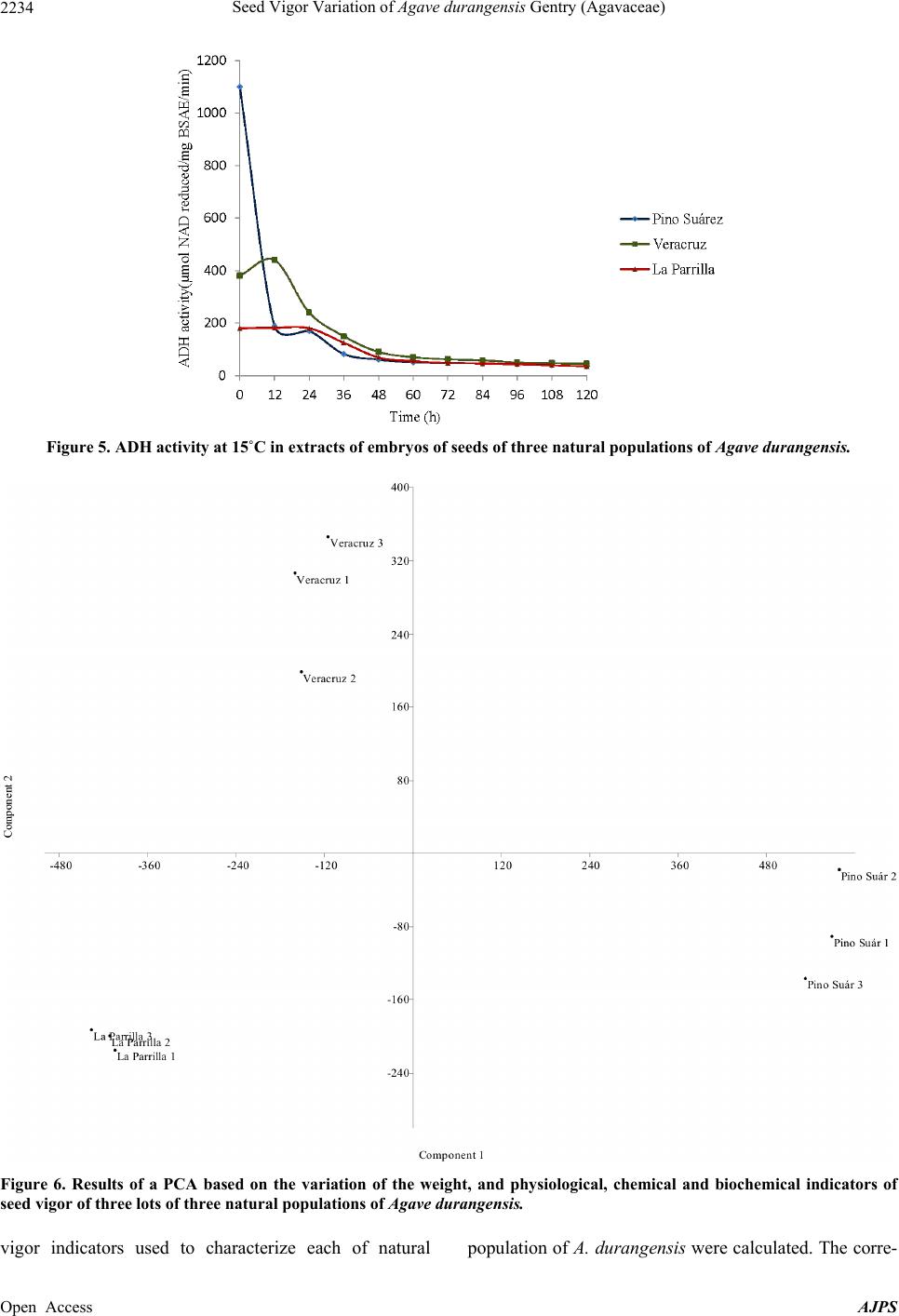 Seed Vigor Variation of Agave durangensis Gentry (Agavaceae) 2234 Figure 5. ADH activity at 15˚C in extracts of embryos of seeds of three natur al populations of Agave durangensis. Figure 6. Results of a PCA based on the variation of the weight, and physiological, chemical and biochemical indicators of seed vigor of three lots of three natural populations of Agave durangensis. vigor indicators used to characterize each of natural population of A. durangensis were calculated. The corre- Open Access AJPS 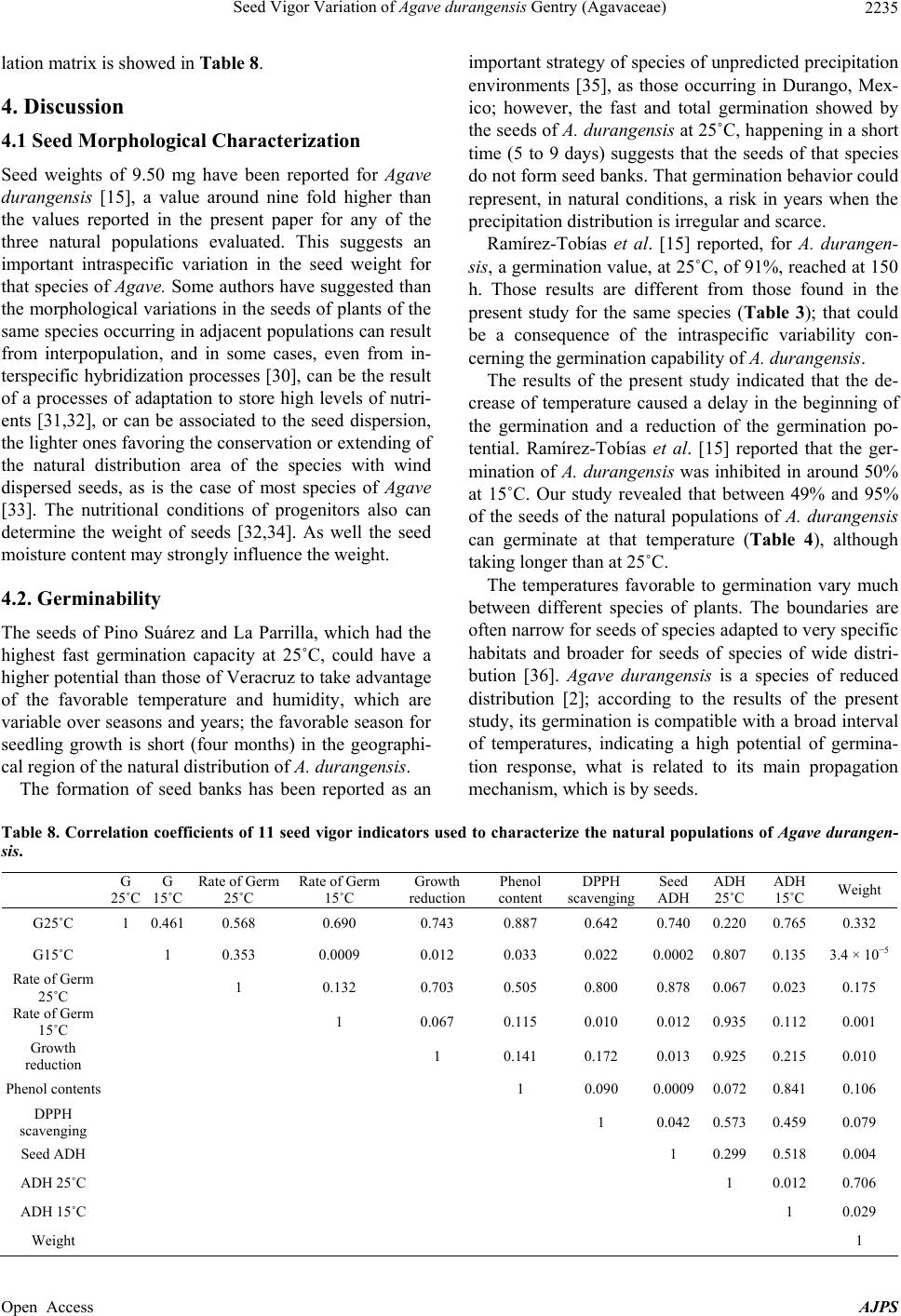 Seed Vigor Variation of Agave durangensis Gentry (Agavaceae) 2235 lation matrix is showed in Table 8. 4. Discussion 4.1 Seed Morphological Characterization Seed weights of 9.50 mg have been reported for Agave durangensis [15], a value around nine fold higher than the values reported in the present paper for any of the three natural populations evaluated. This suggests an important intraspecific variation in the seed weight for that species of Agave. Some authors have suggested than the morphological variations in the seeds of plants of the same species occurring in adjacent populations can result from interpopulation, and in some cases, even from in- terspecific hybridization processes [30], can be the result of a processes of adaptation to store high levels of nutri- ents [31,32], or can be associated to the seed dispersion, the lighter ones favoring the conservation or extending of the natural distribution area of the species with wind dispersed seeds, as is the case of most species of Agave [33]. The nutritional conditions of progenitors also can determine the weight of seeds [32,34]. As well the seed moisture content may strongly influence the weight. 4.2. Germinability The seeds of Pino Suárez and La Parrilla, which had the highest fast germination capacity at 25˚C, could have a higher potential than those of Veracruz to take advantage of the favorable temperature and humidity, which are variable over seasons and years; the favorable season for seedling growth is short (four months) in the geographi- cal region of the natural distribution of A. durangensis. The formation of seed banks has been reported as an important strategy of species of unpredicted precipitation environments [35], as those occurring in Durango, Mex- ico; however, the fast and total germination showed by the seeds of A. durangensis at 25˚C, happening in a short time (5 to 9 days) suggests that the seeds of that species do not form seed banks. That germination behavior could represent, in natural conditions, a risk in years when the precipitation distribution is irregular and scarce. Ramírez-Tobías et al. [15] reported, for A. durangen- sis, a germination value, at 25˚C, of 91%, reached at 150 h. Those results are different from those found in the present study for the same species (Table 3); that could be a consequence of the intraspecific variability con- cerning the germination capability of A. durangensis. The results of the present study indicated that the de- crease of temperature caused a delay in the beginning of the germination and a reduction of the germination po- tential. Ramírez-Tobías et al. [15] reported that the ger- mination of A. durangensis was inhibited in around 50% at 15˚C. Our study revealed that between 49% and 95% of the seeds of the natural populations of A. durangensis can germinate at that temperature (Table 4), although taking longer than at 25˚C. The temperatures favorable to germination vary much between different species of plants. The boundaries are often narrow for seeds of species adapted to very specific habitats and broader for seeds of species of wide distri- bution [36]. Agave durangensis is a species of reduced distribution [2]; according to the results of the present study, its germination is compatible with a broad interval of temperatures, indicating a high potential of germina- tion response, what is related to its main propagation mechanism, which is by seeds. Table 8. Correlation coefficients of 11 seed vigor indicators used to characterize the natural populations of Agave durangen- sis. G 25˚C G 15˚C Rate of Germ 25˚C Rate of Germ 15˚C Growth reduction Phenol content DPPH scavenging Seed ADH ADH 25˚C ADH 15˚C Weight G25˚C 1 0.461 0.568 0.690 0.743 0.887 0.642 0.740 0.220 0.765 0.332 G15˚C 1 0.353 0.0009 0.012 0.033 0.022 0.0002 0.807 0.135 3.4 × 10−5 Rate of Germ 25˚C 1 0.132 0.703 0.505 0.800 0.878 0.067 0.023 0.175 Rate of Germ 15˚C 1 0.067 0.115 0.010 0.012 0.935 0.112 0.001 Growth reduction 1 0.141 0.172 0.013 0.925 0.215 0.010 Phenol contents 1 0.090 0.0009 0.072 0.841 0.106 DPPH scavenging 1 0.042 0.573 0.459 0.079 Seed ADH 1 0.299 0.518 0.004 ADH 25˚C 1 0.012 0.706 ADH 15˚C 1 0.029 Weight 1 Open Access AJPS 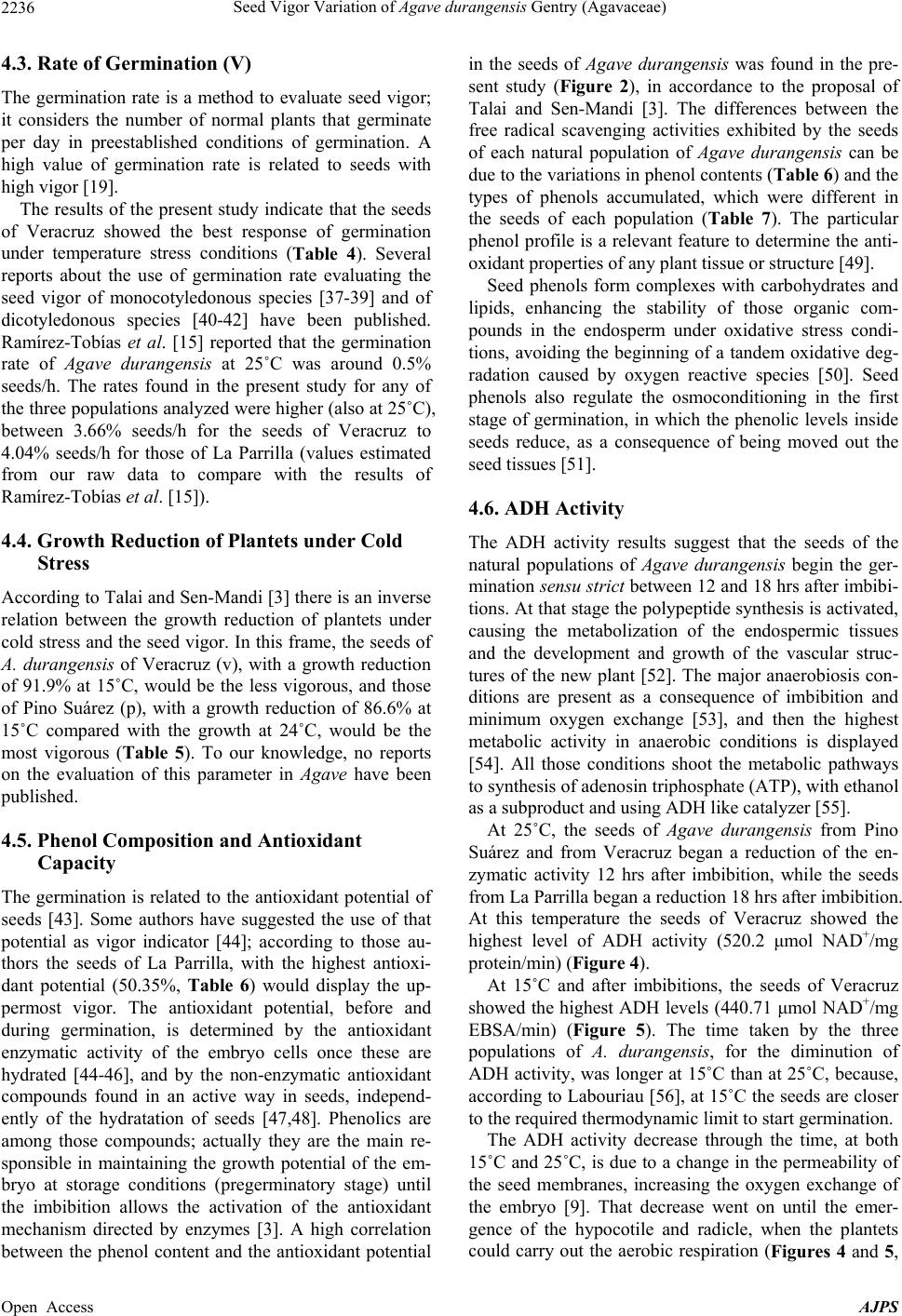 Seed Vigor Variation of Agave durangensis Gentry (Agavaceae) 2236 4.3. Rate of Germination (V) The germination rate is a method to evaluate seed vigor; it considers the number of normal plants that germinate per day in preestablished conditions of germination. A high value of germination rate is related to seeds with high vigor [19]. The results of the present study indicate that the seeds of Veracruz showed the best response of germination under temperature stress conditions (Table 4). Several reports about the use of germination rate evaluating the seed vigor of monocotyledonous species [37-39] and of dicotyledonous species [40-42] have been published. Ramírez-Tobías et al. [15] reported that the germination rate of Agave durangensis at 25˚C was around 0.5% seeds/h. The rates found in the present study for any of the three populations analyzed were higher (also at 25˚C), between 3.66% seeds/h for the seeds of Veracruz to 4.04% seeds/h for those of La Parrilla (values estimated from our raw data to compare with the results of Ramírez-Tobías et al. [15]). 4.4. Growth Reduction of Plantets under Cold Stress According to Talai and Sen-Mandi [3] there is an inverse relation between the growth reduction of plantets under cold stress and the seed vigor. In this frame, the seeds of A. durangensis of Veracruz (v), with a growth reduction of 91.9% at 15˚C, would be the less vigorous, and those of Pino Suárez (p), with a growth reduction of 86.6% at 15˚C compared with the growth at 24˚C, would be the most vigorous (Table 5). To our knowledge, no reports on the evaluation of this parameter in Agave have been published. 4.5. Phenol Composition and Antioxidant Capacity The germination is related to the antioxidant potential of seeds [43]. Some authors have suggested the use of that potential as vigor indicator [44]; according to those au- thors the seeds of La Parrilla, with the highest antioxi- dant potential (50.35%, Table 6) would display the up- permost vigor. The antioxidant potential, before and during germination, is determined by the antioxidant enzymatic activity of the embryo cells once these are hydrated [44-46], and by the non-enzymatic antioxidant compounds found in an active way in seeds, independ- ently of the hydratation of seeds [47,48]. Phenolics are among those compounds; actually they are the main re- sponsible in maintaining the growth potential of the em- bryo at storage conditions (pregerminatory stage) until the imbibition allows the activation of the antioxidant mechanism directed by enzymes [3]. A high correlation between the phenol content and the antioxidant potential in the seeds of Agave durangensis was found in the pre- sent study (Figure 2), in accordance to the proposal of Talai and Sen-Mandi [3]. The differences between the free radical scavenging activities exhibited by the seeds of each natural population of Agave durangensis can be due to the variations in phenol contents (Table 6) and the types of phenols accumulated, which were different in the seeds of each population (Table 7). The particular phenol profile is a relevant feature to determine the anti- oxidant properties of any plant tissue or structure [49]. Seed phenols form complexes with carbohydrates and lipids, enhancing the stability of those organic com- pounds in the endosperm under oxidative stress condi- tions, avoiding the beginning of a tandem oxidative deg- radation caused by oxygen reactive species [50]. Seed phenols also regulate the osmoconditioning in the first stage of germination, in which the phenolic levels inside seeds reduce, as a consequence of being moved out the seed tissues [51]. 4.6. ADH Activity The ADH activity results suggest that the seeds of the natural populations of Agave durangensis begin the ger- mination sensu strict between 12 and 18 hrs after imbibi- tions. At that stage the polypeptide synthesis is activated, causing the metabolization of the endospermic tissues and the development and growth of the vascular struc- tures of the new plant [52]. The major anaerobiosis con- ditions are present as a consequence of imbibition and minimum oxygen exchange [53], and then the highest metabolic activity in anaerobic conditions is displayed [54]. All those conditions shoot the metabolic pathways to synthesis of adenosin triphosphate (ATP), with ethanol as a subproduct and using ADH like catalyzer [55]. At 25˚C, the seeds of Agave durangensis from Pino Suárez and from Veracruz began a reduction of the en- zymatic activity 12 hrs after imbibition, while the seeds from La Parrilla began a reduction 18 hrs after imbibition. At this temperature the seeds of Veracruz showed the highest level of ADH activity (520.2 μmol NAD+/mg protein/min) (Figure 4). At 15˚C and after imbibitions, the seeds of Veracruz showed the highest ADH levels (440.71 μmol NAD+/mg EBSA/min) (Figure 5). The time taken by the three populations of A. durangensis, for the diminution of ADH activity, was longer at 15˚C than at 25˚C, because, according to Labouriau [56], at 15˚C the seeds are closer to the required thermodynamic limit to start germination. The ADH activity decrease through the time, at both 15˚C and 25˚C, is due to a change in the permeability of the seed membranes, increasing the oxygen exchange of the embryo [9]. That decrease went on until the emer- gence of the hypocotile and radicle, when the plantets could carry out the aerobic respiration (Figures 4 and 5, Open Access AJPS 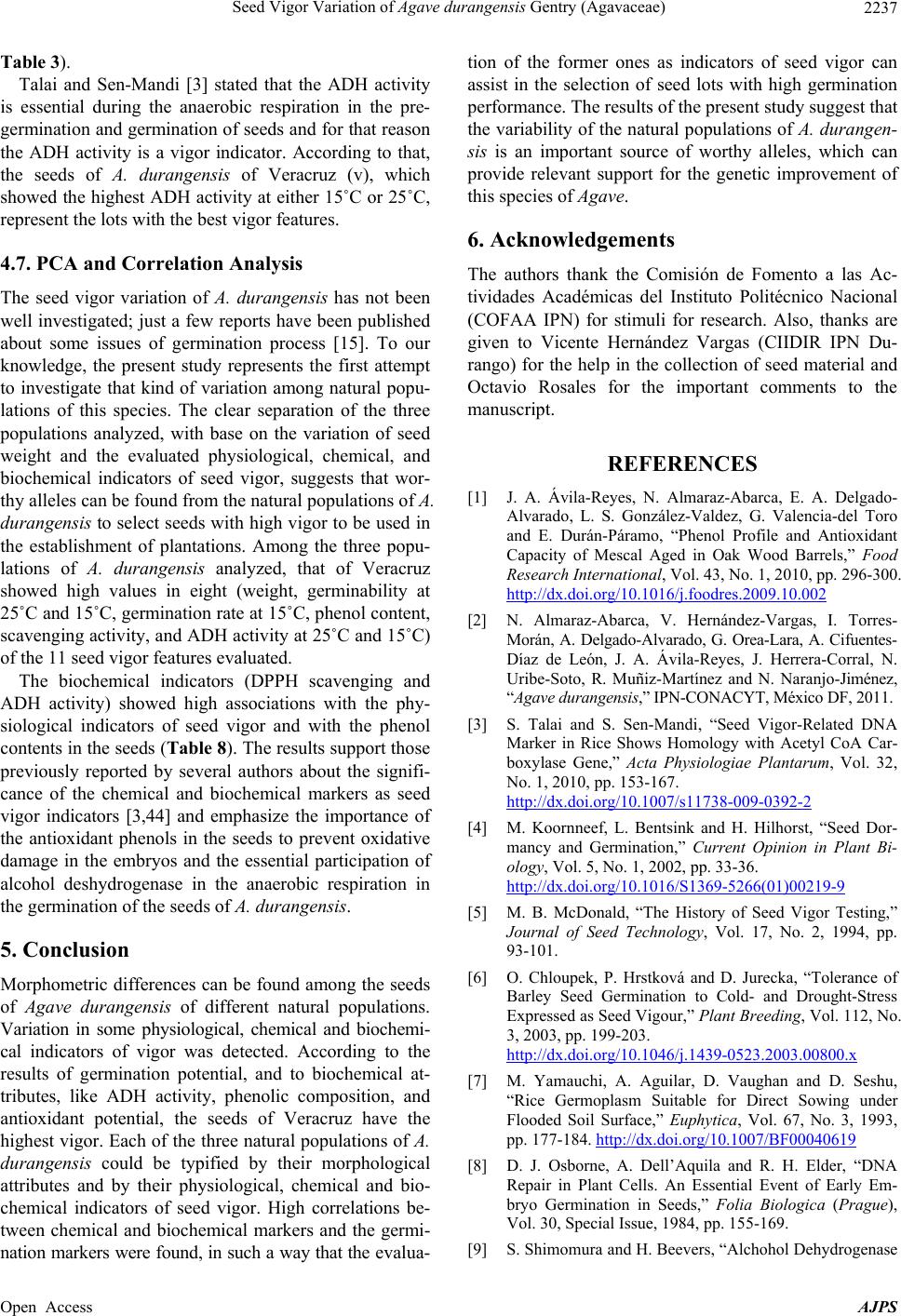 Seed Vigor Variation of Agave durangensis Gentry (Agavaceae) 2237 Table 3). Talai and Sen-Mandi [3] stated that the ADH activity is essential during the anaerobic respiration in the pre- germination and germination of seeds and for that reason the ADH activity is a vigor indicator. According to that, the seeds of A. durangensis of Veracruz (v), which showed the highest ADH activity at either 15˚C or 25˚C, represent the lots with the best vigor features. 4.7. PCA and Correlation Analysis The seed vigor variation of A. durangensis has not been well investigated; just a few reports have been published about some issues of germination process [15]. To our knowledge, the present study represents the first attempt to investigate that kind of variation among natural popu- lations of this species. The clear separation of the three populations analyzed, with base on the variation of seed weight and the evaluated physiological, chemical, and biochemical indicators of seed vigor, suggests that wor- thy alleles can be found from the natural populations of A. durangensis to select seeds with high vigor to be used in the establishment of plantations. Among the three popu- lations of A. durangensis analyzed, that of Veracruz showed high values in eight (weight, germinability at 25˚C and 15˚C, germination rate at 15˚C, phenol content, scavenging activity, and ADH activity at 25˚C and 15˚C) of the 11 seed vigor features evaluated. The biochemical indicators (DPPH scavenging and ADH activity) showed high associations with the phy- siological indicators of seed vigor and with the phenol contents in the seeds (Tab le 8 ). The results support those previously reported by several authors about the signifi- cance of the chemical and biochemical markers as seed vigor indicators [3,44] and emphasize the importance of the antioxidant phenols in the seeds to prevent oxidative damage in the embryos and the essential participation of alcohol deshydrogenase in the anaerobic respiration in the germination of the seeds of A. durangensis. 5. Conclusion Morphometric differences can be found among the seeds of Agave durangensis of different natural populations. Variation in some physiological, chemical and biochemi- cal indicators of vigor was detected. According to the results of germination potential, and to biochemical at- tributes, like ADH activity, phenolic composition, and antioxidant potential, the seeds of Veracruz have the highest vigor. Each of the three natural populations of A. durangensis could be typified by their morphological attributes and by their physiological, chemical and bio- chemical indicators of seed vigor. High correlations be- tween chemical and biochemical markers and the germi- nation markers were found, in such a way that the evalua- tion of the former ones as indicators of seed vigor can assist in the selection of seed lots with high germination performance. The results of the present study suggest that the variability of the natural populations of A. durangen- sis is an important source of worthy alleles, which can provide relevant support for the genetic improvement of this species of Agave. 6. Acknowledgements The authors thank the Comisión de Fomento a las Ac- tividades Académicas del Instituto Politécnico Nacional (COFAA IPN) for stimuli for research. Also, thanks are given to Vicente Hernández Vargas (CIIDIR IPN Du- rango) for the help in the collection of seed material and Octavio Rosales for the important comments to the manuscript. REFERENCES [1] J. A. Ávila-Reyes, N. Almaraz-Abarca, E. A. Delgado- Alvarado, L. S. González-Valdez, G. Valencia-del Toro and E. Durán-Páramo, “Phenol Profile and Antioxidant Capacity of Mescal Aged in Oak Wood Barrels,” Food Research International, Vol. 43, No. 1, 2010, pp. 296-300. http://dx.doi.org/10.1016/j.foodres.2009.10.002 [2] N. Almaraz-Abarca, V. Hernández-Vargas, I. Torres- Morán, A. Delgado-Alvarado, G. Orea-Lara, A. Cifuentes- Díaz de León, J. A. Ávila-Reyes, J. Herrera-Corral, N. Uribe-Soto, R. Muñiz-Martínez and N. Naranjo-Jiménez, “Agave durangensis,” IPN-CONACYT, México DF, 2011. [3] S. Talai and S. Sen-Mandi, “Seed Vigor-Related DNA Marker in Rice Shows Homology with Acetyl CoA Car- boxylase Gene,” Acta Physiologiae Plantarum, Vol. 32, No. 1, 2010, pp. 153-167. http://dx.doi.org/10.1007/s11738-009-0392-2 [4] M. Koornneef, L. Bentsink and H. Hilhorst, “Seed Dor- mancy and Germination,” Current Opinion in Plant Bi- ology, Vol. 5, No. 1, 2002, pp. 33-36. http://dx.doi.org/10.1016/S1369-5266(01)00219-9 [5] M. B. McDonald, “The History of Seed Vigor Testing,” Journal of Seed Technology, Vol. 17, No. 2, 1994, pp. 93-101. [6] O. Chloupek, P. Hrstková and D. Jurecka, “Tolerance of Barley Seed Germination to Cold- and Drought-Stress Expressed as Seed Vigour,” Plant Breeding, Vol. 112, No. 3, 2003, pp. 199-203. http://dx.doi.org/10.1046/j.1439-0523.2003.00800.x [7] M. Yamauchi, A. Aguilar, D. Vaughan and D. Seshu, “Rice Germoplasm Suitable for Direct Sowing under Flooded Soil Surface,” Euphytica, Vol. 67, No. 3, 1993, pp. 177-184. http://dx.doi.org/10.1007/BF00040619 [8] D. J. Osborne, A. Dell’Aquila and R. H. Elder, “DNA Repair in Plant Cells. An Essential Event of Early Em- bryo Germination in Seeds,” Folia Biologica (Prague), Vol. 30, Special Issue, 1984, pp. 155-169. [9] S. Shimomura and H. Beevers, “Alchohol Dehydrogenase Open Access AJPS  Seed Vigor Variation of Agave durangensis Gentry (Agavaceae) 2238 and an Inactivator from Rice Seedlings,” Plant Physiol- ogy, Vol. 71, No. 4, 1983, pp. 736-741. http://dx.doi.org/10.1104/pp.71.4.736 [10] H. Kato-Noguchi, “Ethanol Sensitivity of Rice and Oat Coleoptiles,” Physiologia Plantarum, Vol. 115, No. 1, 2002, pp. 119-124. http://dx.doi.org/10.1034/j.1399-3054.2002.1150114.x [11] C. Bailly, “Active Oxygen Species and Antioxidants in Seed Biology,” Seed Science Research, Vol. 14, No. 2, 2004, pp. 93-107. http://dx.doi.org/10.1079/SSR2004159 [12] B. A. Cevallos-Casals and L. Cisneros-Zevallos, “Impact of Germination on Phenolic Content and Antioxidant Ac- tivity of 13 Edible Seeds Species,” Food Chemistry, Vol. 119, No. 4, 2010, pp. 1485-1490. http://dx.doi.org/10.1016/j.foodchem.2009.09.030 [13] C. E. Freeman, “Germination Responses of a New Mex- ico Population of Parry Agave (Agave parryi Engelm. var. parryi) to Constant Temperature, Water Stress, and pH,” The Southwestern Naturalist, Vol. 20, No. 1, 1975, pp. 69-74. http://dx.doi.org/10.2307/3670012 [14] L. G. Orea, A. Cifuentes-Díaz de León, O. S. Gómez and V. V Hernández, “Seed Germination (Agave durangensis) at different temperatures and Effect of Fertilization on the Plantet Development,” Vidsupra, Vol. 2, No. 1, 2009, pp. 16-21. [15] H. M. Ramírez-Tobías, C. B. Peña-Valdivia, J. R. R. Aguirre, J. A. Reyes-Agüero, A. B. Sánchez-Urdaneta and S. G. Valle, “Seed Germination Temperatures of Eight Mexican Agave Species with Economic Impor- tance,” Plant Species Biology, Vol. 27, No. 2, 2012, pp. 124-137. http://dx.doi.org/10.1111/j.1442-1984.2011.00341.x [16] G. Funes, S. Díaz and P. Venier, “Temperature as Principal Determinative Factor of Germination in Species of Chaco Seco, Argentina,” Ecología Austral, Vol. 19, No. 2, 2009, pp. 129-138. [17] M. K. Kettenring, G. Gardner and S. M. Galatowitsch, “Effects of Light on Seeds Germination of Eight Wetland Carex Species,” Annals of Botany, Vol. 98, No. 4, 2006, pp. 869-874. http://dx.doi.org/10.1093/aob/mcl170 [18] M. Sood and V. Thakur, “Effect of Light and Tempera- ture on Germination Behavior of Aconitum deinorrhizum Stapf,” International Journal of Farm Sciences, Vol. 1, No. 2, 2011, pp. 83-87. [19] J. D. Maguire, “Speed of Germination-Aid in Selection and Evaluation for Seedling Emergence and Vigor,” Crop Science, Vol. 2, No. 2, 1962, pp. 176-177. http://dx.doi.org/10.2135/cropsci1962.0011183X0002000 20033x [20] A. García and J. M. Lasa, “Test of Seed Vigor: Bi- bliographical Review,” Boletin 14 de la Estación Ex- perimental Aula Dei, Zaragoza, 1991. http://digital.csic.es [21] M. R. S. Ardekani, M. Khanavi, M. Hajimahmoodi, M. Jahangiri and A. Hadjiakhoondi, “Comparison of Anti- oxidant Activity and Total Phenol Contents of Some Date Seed Varieties from Iran,” Iranian Journal of Pharma- ceutical Research, Vol. 9, No. 2, 2010, pp. 141-146. [22] H. Lozoya-Saldaña, R. Rivera-Hinojosa and M. T. Colinas- León, “Phenols, Peroxidase and Phenylalanine Ammonia- Lyase: Their Relationship to the Genetic Resisteance Against Late Blight (Phytophthora infestans Mont. De Bary) in Potato (Solanum tuberosum L.) Clones,” Agro- ciencia, Vol. 41, No. 4, 2007, pp. 479-489. [23] M. Campos and K. Markham, “Structure Information from HPLC and On-Line Measured Absorption Spectra: Flavones, Flavonols and Phenolic Acids,” Coimbra Uni- versity Press, Coimbra, 2007. [24] T. J. Mabry, K. R. Markham and M. B. Thomas, “The Systematic Identification of Flavonoids,” Springer-Verlag, New York, 1970. http://dx.doi.org/10.1007/978-3-642-88458-0 [25] M. G. Campos, P. A. Da Cunha, M. C. Navarro and M. P. Utrilla, “Free Radical Scavenger Activity of Bee Pollen,” 17th International Conference on Polyphenols, Palma de Mallorca, 1994, pp. 415-416. [26] M. E. Rumpho and R. A. Kennedy, “Anaerobic Metabo- lism in Germinating Seeds of Echinochloa crus-galli (Barnyard Grass),” Plant Physiology, Vol. 68, No. 1, 1981, pp. 165-168. http://dx.doi.org/10.1104/pp.68.1.165 [27] M. A. Schuler and R. E. Zielinski, “Methods in Plant Molecular Biology,” Academic Press, Millbrae, 1989. [28] Ø. Hammer, D. A. T. Harper and P. D. Ryan, “PAST: Paleontological Statistics Software Package for Education and Data Analysis,” Paleontologia Electronica, Vol. 4, No. 1, 2001, p. 9. [29] H. Gentry, “Agaves of Continental North America,” The University of Arizona Press, Tucson, 1982. [30] M. G. Barbour, J. H. Burk, W. D. Pitts, F. S. Gilliam and M. W. Schwartz, “Terrestrial Plant Ecology,” Benjamin/ Cummings, San Francisco, 1999. [31] H. Baker, “Seed Weight in Relation to Environmental Conditions,” Ecology, Vol. 53, No. 6, 1972, pp. 997-1010. http://dx.doi.org/10.2307/1935413 [32] N. Pesĕv, “Genetic Factors Affecting Maize Tolerance to Low Temperatures at Emergence and Germination,” Theoretical and Applied Genetics, Vol. 40, No. 12, 1970, pp. 351-356. http://dx.doi.org/10.1007/BF00285413 [33] P. S. Nobel, “Environmental Biology of Agaves and Cacti,” Cambridge University Press, New York, 2003. [34] R. Austin and P. Longden, “The Effects of Nutritional Treatments of Seed-Bearing Plants on the Performance of Their Progeny,” Nature, Vol. 205, No. 4973, 1965, pp. 819-820. http://dx.doi.org/10.1038/205819b0 [35] T. Philippi, “Bet-Hedging Germination of Desert Annuals: Beyond the First Year,” American Naturalist, Vol. 142, No. 3, 1993, pp. 474-487. http://dx.doi.org/10.1086/285550 [36] G. F. Pérez and L. J. B. Martínez, “Introducción a la Fisiología Vegetal,” Mundi Prensa, Madrid, 1994. [37] S. J. Martínez, J. V. Vargas, O. M. G. Peña and A. S. Romero, “Speed of Emergence of Inbred Maize Lines,” Revista Mexicana de Ciencias Agrícolas, Vol. 1, No. 3, 2010, pp. 289-304. Open Access AJPS  Seed Vigor Variation of Agave durangensis Gentry (Agavaceae) Open Access AJPS 2239 [38] H. Zhang, L. J. Irving, C. McGill, C. Matthew, D. Zhou and P. Kemp, “The Effects of Salinity and Osmotic Stress on the Germination of Two Barley Varieties: Sodium as an Osmotic Regulator,” Annals of Botany, Vol. 106, No. 6, 2010, pp. 1027-1035. http://dx.doi.org/10.1093/aob/mcq204 [39] M. Mercado and P. Fernández, “Enhancing Rice Seed Germinability and Vigor Through Hydration-Dehydration (HD) Technique,” Philippine Journal of Crop Science, Vol. 27, No. 1, 2002, pp. 13-24. [40] T. Mostarin, S. R. Saha and K. Khatun, “Seed Quality of Bush Bean as Iinfluenced by Different Storage Containers and Conditions,” Journal of Experimental Biosciences, Vol. 3, No. 1, 2012, pp. 83-88. [41] R. R. Sokht-Abandani and M. R. Ramezani, “The Phy- siological Effects on Some Ttraits of Osmopriming Ger- mination of Maize (Zea mays L.), Rice (Oryza sativa L.) and Cucumber (Cucumis sativus L.),” International Jour- nal of Biology, Vol. 4, No. 2, 2012, pp. 132-148. http://dx.doi.org/10.5539/ijb.v4n2p132 [42] R. L. Hassell, R. J. Dufault and T. L. Phillips, “Influence of Temperature Gradients on Triploid and Diploid Wa- termelon Seed Germination,” HortTechnology, Vol. 11, No. 4, 2001, pp. 570-574. [43] C. Bailly, A. Benamar, F. Corbineau and D. Côme, “Free Radical Scavenging as Affected by Accelerated Ageing and Subsequent Priming in Sunflower Seeds,” Physiolo- gia Plantarum, Vol. 104, No. 4, 1998, pp. 646-652. http://dx.doi.org/10.1034/j.1399-3054.1998.1040418.x [44] S. Balešević-T ubi ć, D. Malenčić, M. Tatić and J. Miladi- nović, “Influence of Ageing Process on Biochemical Changes in Sunflower Seed,” Helia, Vol. 28, No. 42, 2005, pp. 107-114. http://dx.doi.org/10.2298/HEL0542107B [45] S. Nandi, S. Sen-Mandi and T. P. Sinha, “Active Oxygen and Their Scavengers in Rice Seeds (Oryza sativa cv. IET4094) Aged under Tropical Environmental Condi- tions,” Seed Science Research, Vol. 7, No. 3, 1997, pp. 253-260. http://dx.doi.org/10.1017/S0960258500003603 [46] U. M. N. Murthy, Y. Liang, P. P. Kumar and W. Sun, “Non-Enzymatic Protein Modification by the Maillard Reaction Reduces the Activities of Scavenging Enzymes in Vigna radiate,” Physiologia Plantarum, Vol. 115, No. 2, 2002, pp. 213-220. http://dx.doi.org/10.1034/j.1399-3054.2002.1150206.x [47] L. Lepiniec, I. Debeaujon, J. M. Routaboul, A. Baudry, L. Pourcel, N. Nesi and M. Caboche, “Genetics and Bio- chemistry of Seed Flavonoids,” Annual Review of Plant Physiology, Vol. 57, 2006, pp. 405-430. http://dx.doi.org/10.1146/annurev.arplant.57.032905.1052 52 [48] S. Pukacka and E. Ratajczak, “Age-Related Biochemical Changes during Storage of Beech (Fagus sylvatica L.) Seeds,” Seed Science Research, Vol. 17, No. 1, 2007, pp. 45-53. http://dx.doi.org/10.1017/S0960258507629432 [49] L. G. Barriada-Bernal, N. Almaraz-Abarca, E. A. Del- gado-Alvarado, T. Gallardo-Velázquez, J. A. Ávila-Reyes, M. I. Torrres-Morán, M. S. González-Elizondo and Y. Herrera-Arrieta, “Flavonoid Composition and Antioxi- dant Capacity of the Edible Flowers of Agave durangen- sis (Agavaceae),” CyTA-Journal of Food, Published on- line: 14 Jun 2013. http://dx.doi.org/10.1080/19476337.2013.801037 [50] F. Abderrahim, E. Huanatico, R. Repo-Carrasco-Valencia, S. M. Arribas, M. C. Gonzalez and L. Condezo-Hoyos, “Effect of Germination on Total Phenolic Compounds, Total Antioxidant Capacity, Maillard Reaction Products and Oxidative Stress Markers in Canihua (Chenopodium pallidicaule),” Journal of Cereal Science, Vol. 56, No. 2, 2012, pp. 410-417. http://dx.doi.org/10.1016/j.jcs.2012.04.013 [51] Z. S. Siddiqui and M. A. Khan, “The Role of Seed Coat Phenolics on Water Uptake and Early Protein Synthesis during Germination of Dimorphic Seeds of Halopyrum mucronatum (L.) Staph,” Pakistan Journal of Botany, Vol. 42, No. 1, 2010, pp. 227-238. [52] J. Bewley and M. Black, “Seeds: Physiology of Devel- opment and Germination,” Plenum Press, New York, 1994. [53] D. Priestley, “Seed Ageing. Implications for Seed Storage and Persistence in the Soil,” Cornell University Press, Ithaca, 1986. [54] M. C. Drew, “Oxygen Deficiency and Root Metabolism; Injury and Acclimation under Hypoxia and Anoxia,” An- nual Review of Plant Physiology and Plan Molecular Bi- ology, Vol. 48, 1997, pp. 223-250. http://dx.doi.org/10.1146/annurev.arplant.48.1.223 [55] D. Schwartz, “An Example of Gene Fixation Resulting from Selective Advantage in Suboptimal Conditions,” The American Naturalist, Vol. 103, No. 933, 1969, pp. 479-481. http://dx.doi.org/10.1086/282615 [56] L. G. Labouriau, “Seed Germination as a Thermobiologi- cal Problem,” Radiation and Environmental Biophysics, Vol. 15, No. 4, 1978, pp. 345-366. http://dx.doi.org/10.1007/BF01323460
|